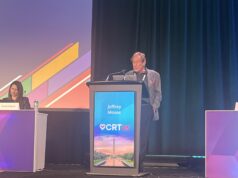
Data from the TOPIC (Timing of platelet inhibition after acute coronary syndrome) study indicate that swapping a new potent P2Y212 blocker for the less potent clopidogrel one month after an acute coronary syndrome event in patients receiving dual antiplatelet therapy (DAPT) significantly reduces bleeding events without increasing ischaemic events.
Writing in the European Heart Journal, Thomas Cuisset (Department de Cardiologie, CHU Timone, Marseille, France) and others report that newer P2Y12 blockers—prasugrel (Efient, Eli Lilly and Daiichi Sankyo) and ticagrelor (Brilinta, AstraZeneca)—significantly reduce ischaemic events compared with clopidogrel when used as part of a DAPT regimen in patients with acute coronary syndrome. However, they add that the newer P2Y12 blockers are also associated with increased bleeding complications and that their ischaemic benefit is greatest during the first month after an acute coronary syndrome event. The purpose of TOPIC, therefore, was to explore the safety and efficacy of switching, one month after an event, from the guideline-recommended DAPT regimen of aspirin and a newer P2Y12 inhibitor to a regimen involving a fixed dose combination of aspirin and clopidogrel.
In the study, 646 patients with acute coronary syndrome were randomised to the switched DAPT regimen group (323) or to the unchanged DAPT regimen group (323). At one year, the primary endpoint—a composite of cardiovascular death, unplanned hospitalisation leading to urgent coronary revascularisation, stroke and bleeding episodes—occurred significantly less frequently in the switched DAPT group: 13.4% vs. 26.3% for the unchanged DAPT group (p<0.01).
This reduction was driven by significantly fewer bleeding events in this group—defined as Bleeding Academic Research Consortium (BARC) ≥2—4% for the switched DAPT group compared with 14.9% for the unchanged DAPT group (p<0.01). Furthermore, all BARC events were significantly reduced in the switched DAPT group (9.3% vs. 23.5%, respectively; p<0.01). However while the switched DAPT regimen was associated with significant reductions in Thrombolysis In Myocardial Infarction (TIMI) minor and minimal bleeding events, it was not associated with a significant reduction in TIMI major bleeding events (0.3% vs. 1.2% for the unchanged DAPT regimen; p=0.18).
There were no significant differences between groups in ischaemic events (9.3% for the switched DAPT group compared with 11.5% for the unchanged DAPT group; p=36) or in the rate of unplanned revascularisation (8.7% vs. 9.3%, respectively; p=0.78). Additionally, the rate of stent thrombosis was low overall and not significantly different between groups.
According to Cuisset et al, the study’s finding is of “major relevance” to the real-world management of patients with acute coronary syndrome patients and “offers an efficient and cost-effective alternative for acute coronary syndrome therapy, particularly in those with a higher bleeding risk and drug compliance concerns”.
Speaking to Cardiovascular News, Cuisset says that the switch strategy used in TOPIC should—at present—only be considered as a “possible” strategy in post-acute coronary syndrome patients rather than a “routine” one because of the limitations of the study (ie. the relatively small number of patients. He adds: “The next step will be to identify which patients with be suitable candidates for this switch strategy”. However, he notes that patients at high risk of bleeding already discharged on clopidogrel “and therefore, there would not be a question about a switch” and comments that, on the other hand, patients at high risk of thrombotic should not be switched to clopidogrel after one month. The challenge, Cuisset believes, is to find those high-risk patients “with criteria related to clinical presentation (eg, ST-segment elevation myocardial infarction), certain comorbidities (such as diabetes), or to the PCI procedure itself”.
If patients are to be switched from a newer P2Y12 blocker to a clopidogrel after one month, according to Cuisset, the main immediate risk is the drug-drug interaction between ticagrelor and clopidogrel (which has not been observed between prasugrel and clopidogrel). “To avoid or limit this risk, we should wait at least 12 hours between last intake of ticagrelor and clopidogrel initiation,” he comments.
Coinciding with the publication in the European Heart Journal, Cuisset presented the results of TOPIC at EuroPCR (16–19 May, Paris, France).













